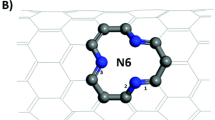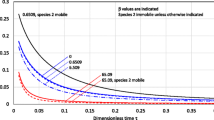Abstract
Abstract
The chemical strain effect in solids is the deviation from linear elasticity due to the association and dissociation of point defects. Although to date this effect has been observed and studied only in Ce0.8Gd0.2O1,9, one may expect that it will be found in other ionic and mixed conductors containing a large concentration of point defects. In this work, some practical applications of materials exhibiting the chemical strain effect are discussed. Based on the example of Ce0.8Gd0.2O1,9, mechanical structures built from these materials should exhibit exceptional mechanical stability and are therefore very attractive for use as components of solid oxide fuel cells (SOFC) or other devices subjected to large and frequent temperature variations. The ability of these materials to withstand large strain without accumulating large stress also makes them potentially useful as flexible elements in micro-electromechanical systems (MEMS).
Graphical abstract



Similar content being viewed by others
References
Greenberg M, Wachtel E, Lubomirsky I, Fleig J, Maier J (2006) Adv Funct Mater 16:48–52
Kossoy A, Feldman Y, Wachtel E, Lubomirsky I, Maier J (2007) Adv Funct Mater 17:2393–2398
Kossoy A, Isai F, Korobko R, Wachtel E, Lubomirsky I, Maier J (2009) Adv Funct Mater 19(4):634
Lubomirsky I (2007) Phys Chem Chem Phys 9:3701–3710
Atkinson A, Sun B (2007) Mater Sci Technol 23:1135–1143
Tang YH, Stanley K, Wu J, Ghosh D, Zhang JJ (2005) J Micromech Microeng 15:S185–S192
Maluf N, Williams K (2004) An introduction to MEMS engineering. Artech House, Boston
Kovacs GTA (1999) Micromachined transducers sourcebook, 1st edn. WCB/McGraw Hill, NY
Larche FC, Cahn JW (1982) Acta Metall 30:1835–1845
Larche F, Cahn JW (1973) Acta Metall 21:1051–1063
Katsuki M, Wang SR, Yasumoto K, Dokiya M (2002) Solid State Ionics 154:589–595
Wang DY, Park DS, Griffith J, Nowick AS (1981) Solid State Ionics 2:95–105
Butler V, Catlow CRA, Fender BEF, Harding JH (1983) Solid State Ionics 8:109–113
Tschope A (2005) J Electroceramics 14:5–23
Duncan KL, Wang YL, Bishop SR, Ebrahimi F, Wachsman ED (2007) J Appl Phys 101
Lubomirsky I (2006) Solid State Ionics 177:1639–1642
Knauth P, Tuller HL (2002) J Am Ceram Soc 85:1654–1680
Maier J (2004) Physical chemistry of ionic materials: ions and electrons in solids. Wiley, NY
Inaba H, Tagawa H (1996) Solid State Ionics 83:1–16
Rivera A, Santamaria J, Leon C (2001) Appl Phys Lett 78:610–612
Green DJ (1998) An introduction to the mechanical properties of ceramics. Cambridge University Press, Cambridge
Atkinson A (1997) Solid State Ionics 95:249–258
Wang SR, Katsuki M, Hashimoto T, Dokiya M (2003) J Electrochem Soc 150:A952–A958
Bloom F, Coffin D (2001) Handbook of thin plate buckling and postbuckling. Chapman & Hall/CRC, London/New York
Nair JP, Wachtel E, Lubomirsky I, Fleig J, Maier J (2003) Adv Mater 15:2077
Baertsch CD, Jensen KF, Hertz JL, Tuller HL, Vengallatore ST, Spearing SM, Schmidt MA (2004) J Mater Res 19:2604–2615
Author information
Authors and Affiliations
Corresponding author
Rights and permissions
About this article
Cite this article
Lubomirsky, I. Practical applications of the chemical strain effect in ionic and mixed conductors. Monatsh Chem 140, 1025–1030 (2009). https://doi.org/10.1007/s00706-009-0122-x
Received:
Accepted:
Published:
Issue Date:
DOI: https://doi.org/10.1007/s00706-009-0122-x




